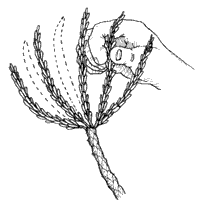Annual Tasks
Spring
A 2 to 3 inch layer of an attractive organic material such as wood chips, shredded bark, dried needles or chopped leaves spread under Douglas firs helps keep the soil moist by limiting run-off and evaporation. For more information about mulching click here.
Summer
Douglas firs require moist soil. New, young trees need regular watering their first season, especially if rain is scarce. Do not allow the soil to get soggy, though. Well established trees need watering only during periods of drought. For more info on watering trees click here.
Fall
Fertilizing helps Douglas firs to maintain healthy strong color, rapid growth and pest and disease resistance. Each fall for the first few years after planting, October or later, sprinkle a granular, all-purpose slow acting fertilizer or one labeled for acid loving plants on the soil under the tree out as far as the branches reach (the drip line), or even 50% farther away than the distance from the trunk to the drip line, for the rain to water in. The roots will grow past the drip line. Use only a small handful for containerized young trees. For larger trees, use about 1 pound of fertilizer for each inch of trunk diameter. Be careful not to use too much and do not let it touch the foliage, branches or trunk. For more info on fertilizing trees click here.
Winter
In the North winter sun and wind are enemies of needled evergreens. They dry out and burn exposed foliage. Locate Douglas firs in areas that are somewhat sheltered from strong wind, to the north or east of buildings on the property. Consider erecting a simple screen of burlap to block wind. Do not wrap trees and cut off all air circulation. A good winter mulch, never more than 4 inches deep, insulates the soil somewhat against extreme temperature fluctuations which might cause it to heave and disturb roots of young trees. For more info on winter protection click here.
Douglas firs do not require pruning, as they have a lovely natural shape. However, it may be necessary to remove dead or broken branches from time to time. Sometimes it is desirable to shape a containerized tree, especially if it is a Christmas tree. Clip off about 1/2 of the new growth, the "candles", that appears at the ends of branches in the spring to encourage density. Do not remove all new growth.


